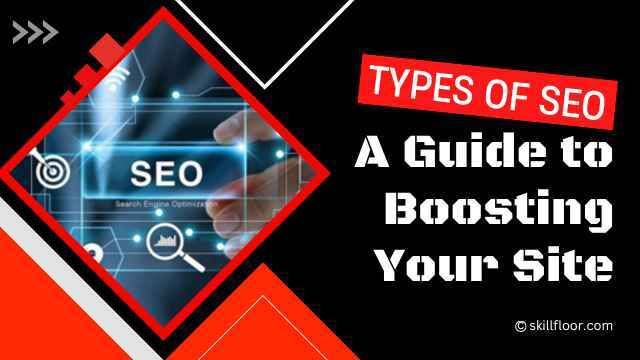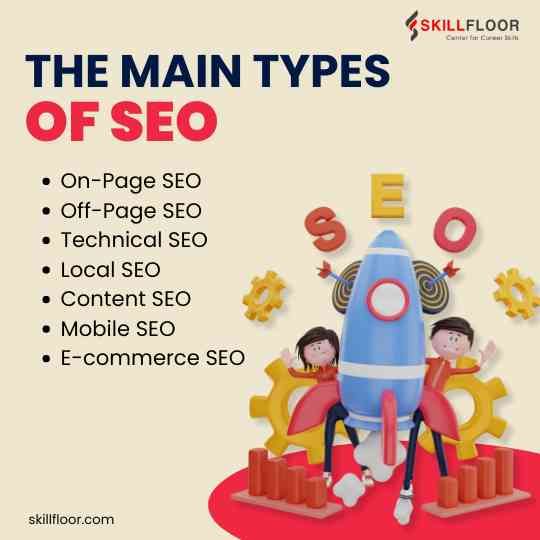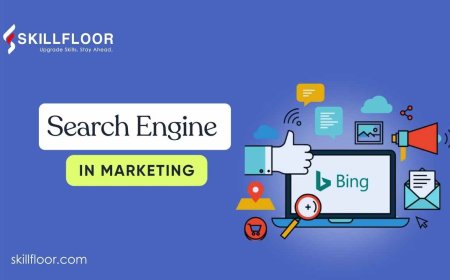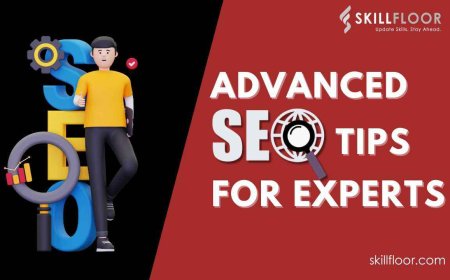What are the types of SEO and its uses?
Learn about the main types of SEO—on-page, off-page, technical, local, content, mobile, and e-commerce—and how they work together to boost online visibility.

Have you ever wondered why some websites are so regularly visible at the top of Google's search results, while others are difficult to find? Why is a certain blog article or online store easier to find than others? A strong technique known as search engine optimization, or SEO, holds the key to the answer. Having an understanding of SEO and, more importantly, the various types of SEO can significantly impact the online performance of your website or content.
To improve your online visibility, Let's explore the many types of SEO this and how they enhance one another. Understanding SEO may help you become more visible and successful in the digital world, regardless of whether you're working on a blog, managing a business, or are just interested in digital marketing. Let's get started and look at the different types of SEO and how they are used.
What is SEO?
Let's first understand SEO before analyzing the different types of SEO. The term SEO, or search engine optimization, defines the techniques and strategies used to improve a site's ranking on search engine result pages (SERPs), thus increasing both the quantity and quality of traffic to it. Making your website attractive to search engines like Google which uses algorithms to rank websites based on elements like user experience, authority, site speed, and content relevance is a way to do this.
SEO is simply about improving search engines' understanding of your content so they can present it to the right target at the right time. But SEO is a multiple term that combines various techniques, each of which plays an individual role in enhancing the functionality of your website.
The Main Types of SEO
There are multiple distinct categories under SEO, each focusing on a certain component of optimization. The main types of SEO include:
-
On-Page SEO
-
Off-Page SEO
-
Technical SEO
-
Local SEO
-
Content SEO
-
Mobile SEO
-
E-commerce SEO

For your website to rank well in search engines, each of these types is important. Let's explore each one more closely to see how it works.
1. On-Page SEO
The goal of on-page SEO is to improve each of your website's pages so that search engines will find them more relevant. This involves improving HTML tags, internal linking, keyword placement, and content quality.
How It Works:
The main goal of on-page SEO is to make your website easy to read and understand for both search engine algorithms and viewers. This includes selecting keywords that users are likely to search for, making sure your headings and titles are reasonable and using meta descriptions that provide an overview of the content of your page.
Uses:
Let's say you're writing an article on the most healthy weight-loss recipes. Including this keyword (and related keywords) naturally in your content, structuring your headings to bring out important points, and making sure your page is simple to use is all part of on-page SEO. Your goal is to help search engines determine the relevancy of your page so that it appears when users perform searches that are related.
Key Elements of On-Page SEO:
-
Keywords: Include relevant keywords throughout the content.
-
Meta Descriptions: A summary of the page content that appears in search results.
-
Headings: Structured headings (H1, H2, H3) that organize content.
-
Internal Linking: Linking to other relevant pages on your site.
By optimizing these elements, you can improve both user experience and search engine rankings.

2. Off-Page SEO
The term "off-page SEO" describes activities you perform off your website to impact your search engine ranking. Building backlinks from other reputable websites to yours is the main goal of off-page SEO since it tells search engines that your website is trustworthy and authoritative.
How It Works:
When a website links to yours, it's similar to that website giving you a vote of confidence. Backlinks are a tool used by search engines, especially Google, to determine a website's authority and credibility. You will most likely rank higher in search results if you have a greater number of high-quality backlinks.
Uses:
Imagine you have a blog about personal finance and one of your posts is linked to by a reputable financial release. By indicating to search engines that your content is trustworthy, this backlink will help you rank higher. Off-page SEO can have a big impact in competitive fields and is important for increasing the domain authority of your website.
Key Elements of Off-Page SEO:
-
Backlinks: Links from other reputable sites to yours.
-
Social Media: While not a direct ranking factor, social shares can drive traffic and build awareness.
-
Guest Blogging: Writing content for other websites to earn backlinks.
-
Influencer Marketing: Collaborating with influencers to promote your site.
Off-page SEO is an important part of an SEO plan because it produces higher ranks and more traffic over the long run, but it does require constant work and networking.
3. Technical SEO
Technical SEO makes sure a website meets search engine algorithm needs by improving its technical components. In order to make your website user-friendly and working, it focuses on making it easy to crawl, index, and navigate.
How It Works:
Mobile optimization, secure connections (HTTPS), XML sitemaps, and site speed are all covered by technical SEO. These components enable more effective website crawling and understanding by search engines. Even a site with outstanding content may rank lower if it is slow or poorly structured.
Uses:
Technical SEO involves making sure your website operates quickly, works well on mobile devices, and has an organized structure that makes it simple for search engines to crawl your pages if you own an online store. Both the user experience and search engine optimization are enhanced by this.
Key Elements of Technical SEO:
-
Page Speed: Ensuring that your website loads quickly on all devices.
-
Mobile Optimization: Make your site fully responsive and mobile-friendly.
-
Secure Site: Using HTTPS to ensure secure communication between users and your site.
-
Crawlability: Ensuring search engines can easily access and index your site’s content.
Though it frequently works in the background, technical SEO is essential to a website's ability to function well. Even with excellent content, your website may have trouble ranking without it.
4. Local SEO
Optimizing a website for local search results is the main goal of local SEO. Businesses that operate in specific areas, such as restaurants, salons, or local services, should pay special attention to this kind of SEO.
How It Works:
Local SEO techniques are designed to make your business more visible in searches related to the area in which it operates. For example, businesses with strong local SEO efforts are more likely to perform well in search results when someone searches for "plumber near me." Here, Google My Business, local citations, and feedback from customers are important factors.
Uses:
Imagine running a coffee shop in the area. Optimizing your Google My Business profile, making sure your company information is consistent throughout all directories, and encouraging customers to provide positive feedback are all part of local SEO. This makes it easier for customers in the area to find your company when it shows up in local search results.
Key Elements of Local SEO:
-
Google My Business: Optimize your profile with accurate details, reviews, and posts.
-
NAP Consistency: Ensure your Name, Address, and Phone number are the same across all directories.
-
Customer Reviews: Encourage and respond to customer reviews to boost trust.
-
Local Keywords: Use location-specific keywords like “best coffee shop in [city].”
For local online conversions and foot traffic, local SEO is important. It can have an important effect on small companies attempting to draw customers in the area.
5. Content SEO
Optimizing the actual content on your website is the main goal of content SEO. Relevant, high-quality content is one of the key elements that search engines consider when giving a score. In order to ensure that your content fulfills the needs of your target audience and ranks highly in search results, content SEO involves creating and optimizing it.
How It Works:
Adding value is the foundation of content SEO. Creating thorough, well-researched content is essential because search engines look for to rank pages that effectively respond to user queries. Important components of content SEO are keyword placement, LSI (Latent Semantic Indexing) keywords, and user intent.
Uses:
Let's imagine you run a blog on fitness. You would develop articles that fully address frequently questioned topics, such as "beginner workout routines" or "how to lose weight safely," to maximize the SEO of your content. You would naturally use appropriate phrases, break the text into small sections, and offer helpful advice to keep readers engaged.
Key Elements of Content SEO:
-
Keyword Optimization: Using relevant and related keywords in your content.
-
User Intent: Creating content that aligns with what users are searching for.
-
Content Structure: Using headers, bullet points, and clear paragraphs.
-
Multimedia: Including images, videos, or infographics to enhance content.
Content that works More than just keywords, SEO is about creating interesting, useful content that attracts readers in and encourages them to take action.
6. Mobile SEO
Your website will be mobile-friendly by using mobile SEO. Now that mobile traffic exceeds desktop traffic, it is essential to ensure that your website functions properly across all platforms.
How It Works:
Mobile SEO involves developing a responsive website, which means that it will change its layout to meet the screen size of the device it is being viewed on. In addition, it works on improving load times, optimizing information for smaller screens, and ensuring that all functions work perfectly on mobile devices.
Uses:
Let's imagine you own an online clothes business and most of your customers purchase from cellphones. Making sure your website loads quickly, looks good, and is simple to use on a mobile device is part of mobile SEO. This ensures an excellent buying experience, increasing conversions.
Key Elements of Mobile SEO:
-
Mobile-Responsive Design: Your site adapts to different screen sizes automatically.
-
Fast Load Times: Optimizing images and code for quicker loading.
-
Readability: Ensuring fonts and buttons are easy to read and click on mobile.
-
User-Friendly Navigation: Simplifying menus and layout for smaller screens.
In the modern digital environment, mobile search engine optimization is essential, especially as Google uses mobile-first indexing, which focuses its ranking mostly on the mobile version of the content.
7. E-commerce SEO
Specialized SEO for online stores is known as e-commerce SEO. It focuses on optimizing product pages, category sites, and other e-commerce-specific content to bring in more customers and boost revenue.
How It Works:
The goal of e-commerce SEO is to make your products easily found on search engines. This includes using excellent photos, updating product descriptions, and making sure the user experience is perfect. Schema markup is also important in e-commerce SEO because it gives search engines more details about your products.
Uses:
E-commerce SEO requires you to make sure every product page is optimized with appropriate keywords, excellent photos, and thorough descriptions if you own an online store selling handmade jewellery. To minimize shopping cart abandonment, you should also make sure that your website is simple to use and has a smooth checkout process.
Key Elements of E-commerce SEO:
-
Product Descriptions: Use unique, keyword-rich descriptions for each product.
-
Category Pages: Optimize categories with relevant keywords and clear organization.
-
Schema Markup: Add schema for product details like price, availability, and reviews.
-
Image Optimization: Use high-quality images that are also compressed for fast load times.
E-commerce SEO can directly impact your sales by improving visibility and ensuring a smooth customer journey from product discovery to purchase.
How the Different Types of SEO Work Together
While each type of SEO helps significantly to enhancing the usability of your website, they are not mutually exclusive. All SEO techniques are used in a comprehensive SEO strategy to make sure your website is helpful to search engines and customers alike. For example, off-page SEO promotes the trustworthiness of your website, technical SEO makes sure it functions properly, and on-page SEO may help search engines understand your content.
Developing experience in different types of SEO is important for creating a strong online presence. Every form of SEO is essential to achieving your goals, whether you're focusing on local SEO to draw customers in your area, off-page SEO to establish trustworthiness, or on-page SEO to enhance your content.
Having an extensive SEO strategy that includes each of these components will help you rank higher in search results, increase organic traffic, and get better results generally. Understanding and using these SEO techniques can position you for long-term success in the dynamic field of digital marketing, no matter whether you run a small business, blog, or e-commerce website.




























































